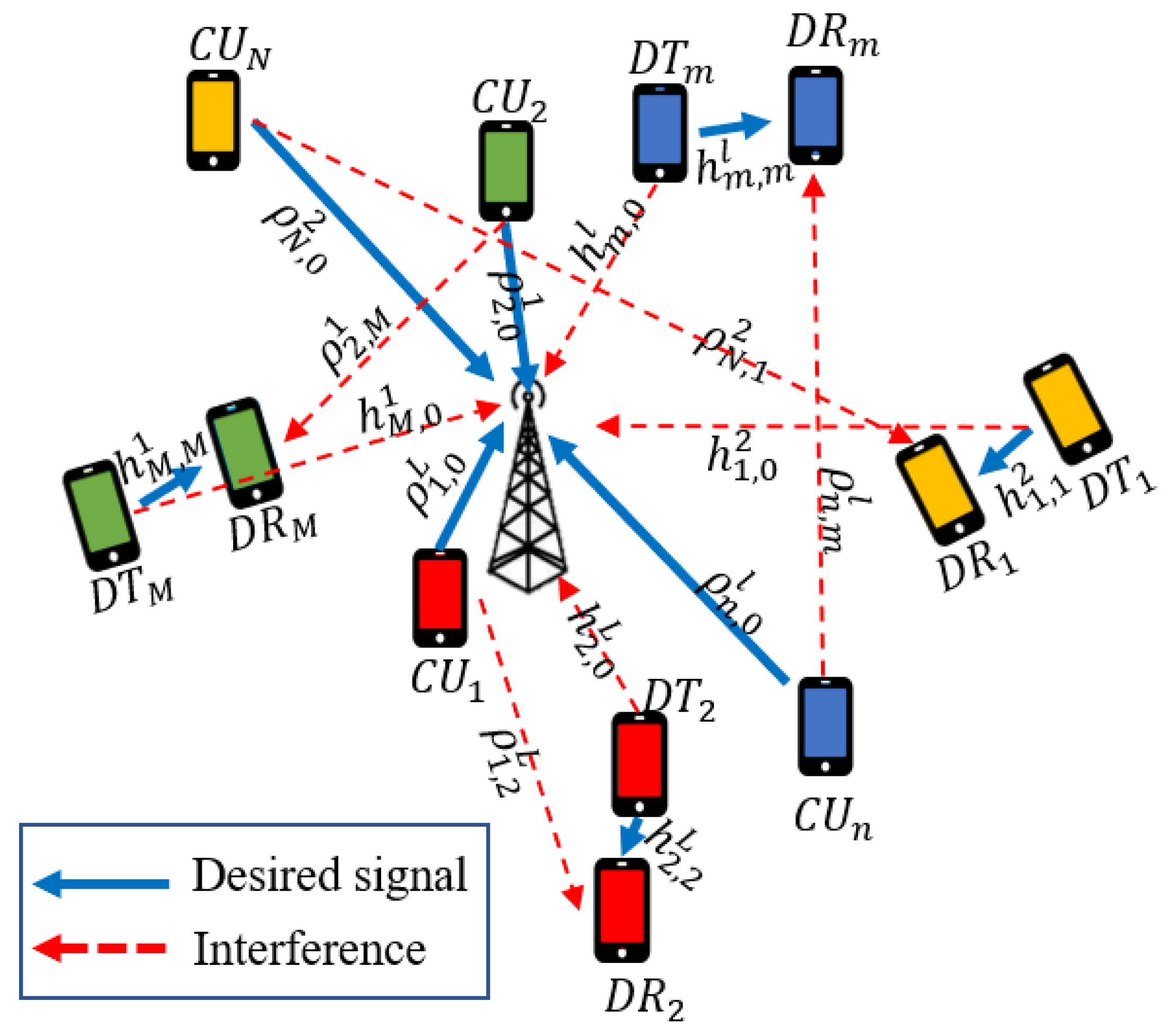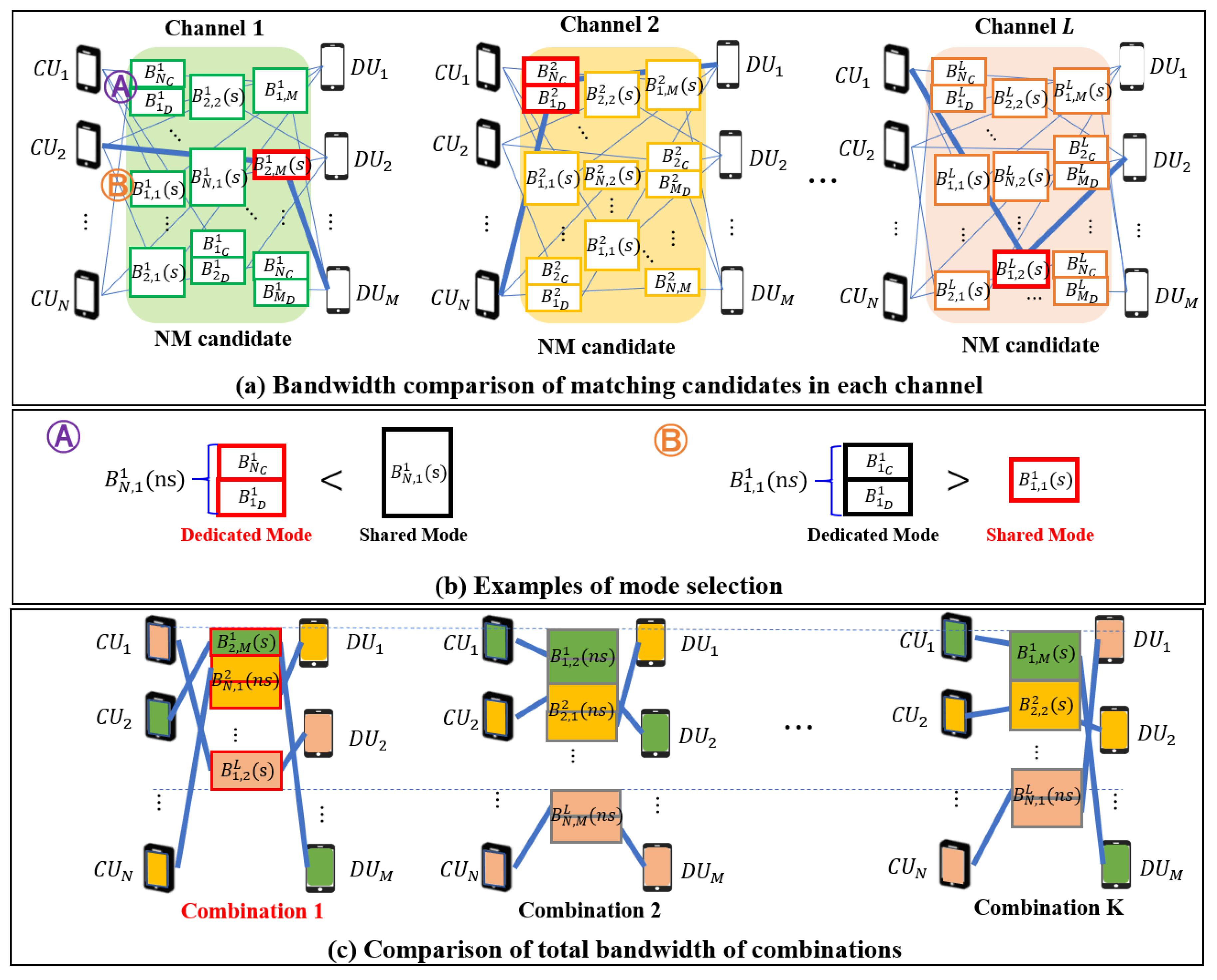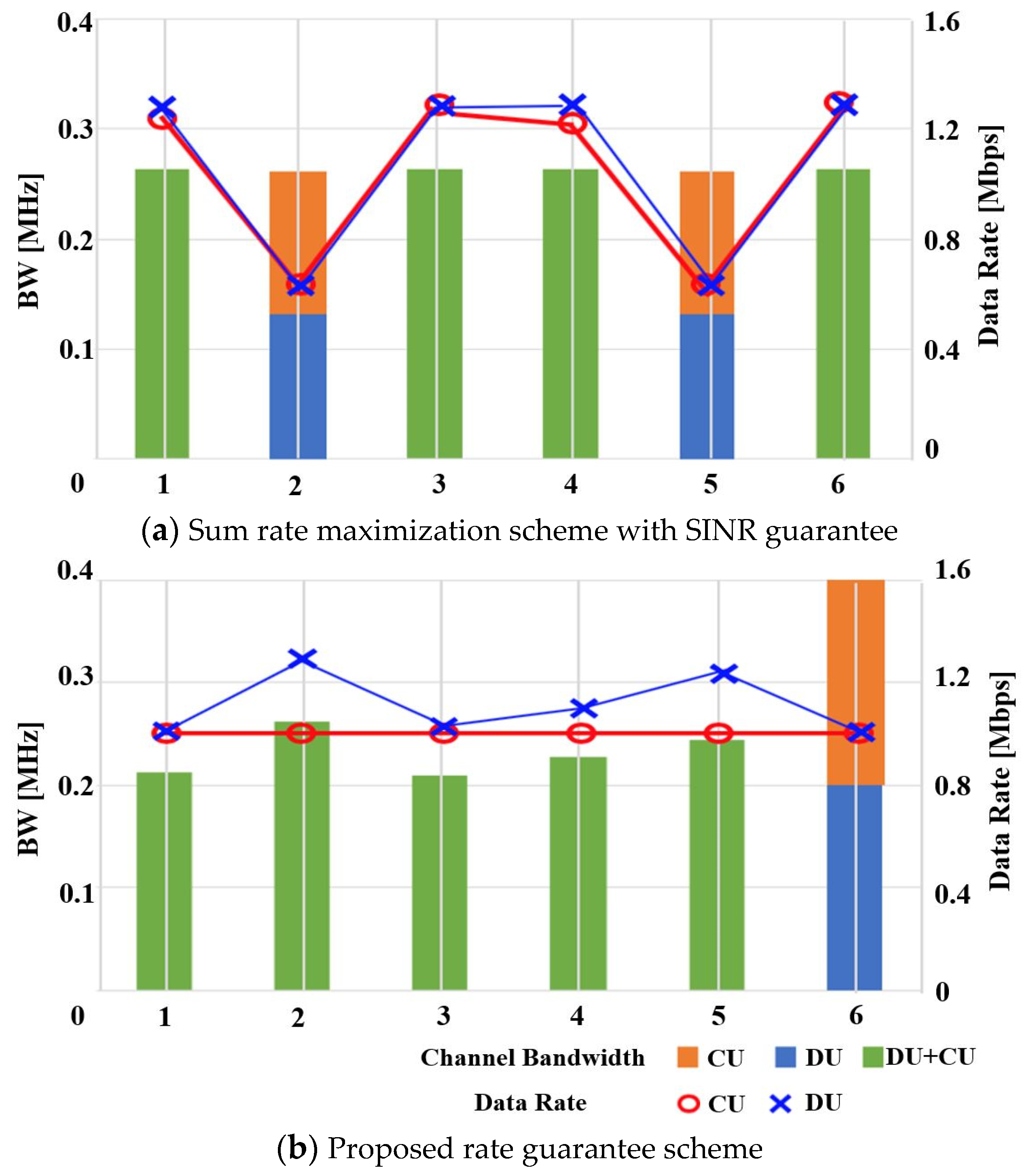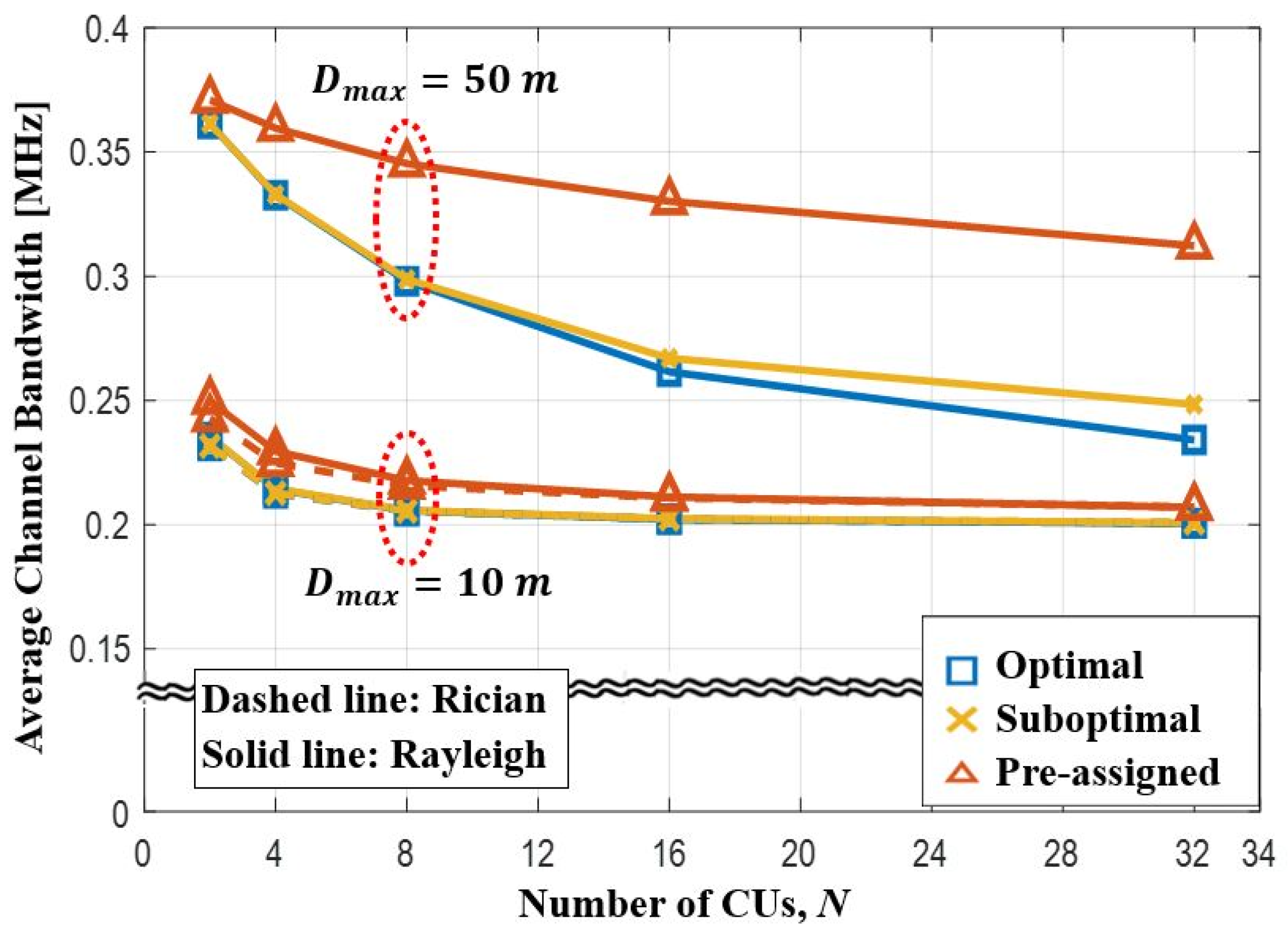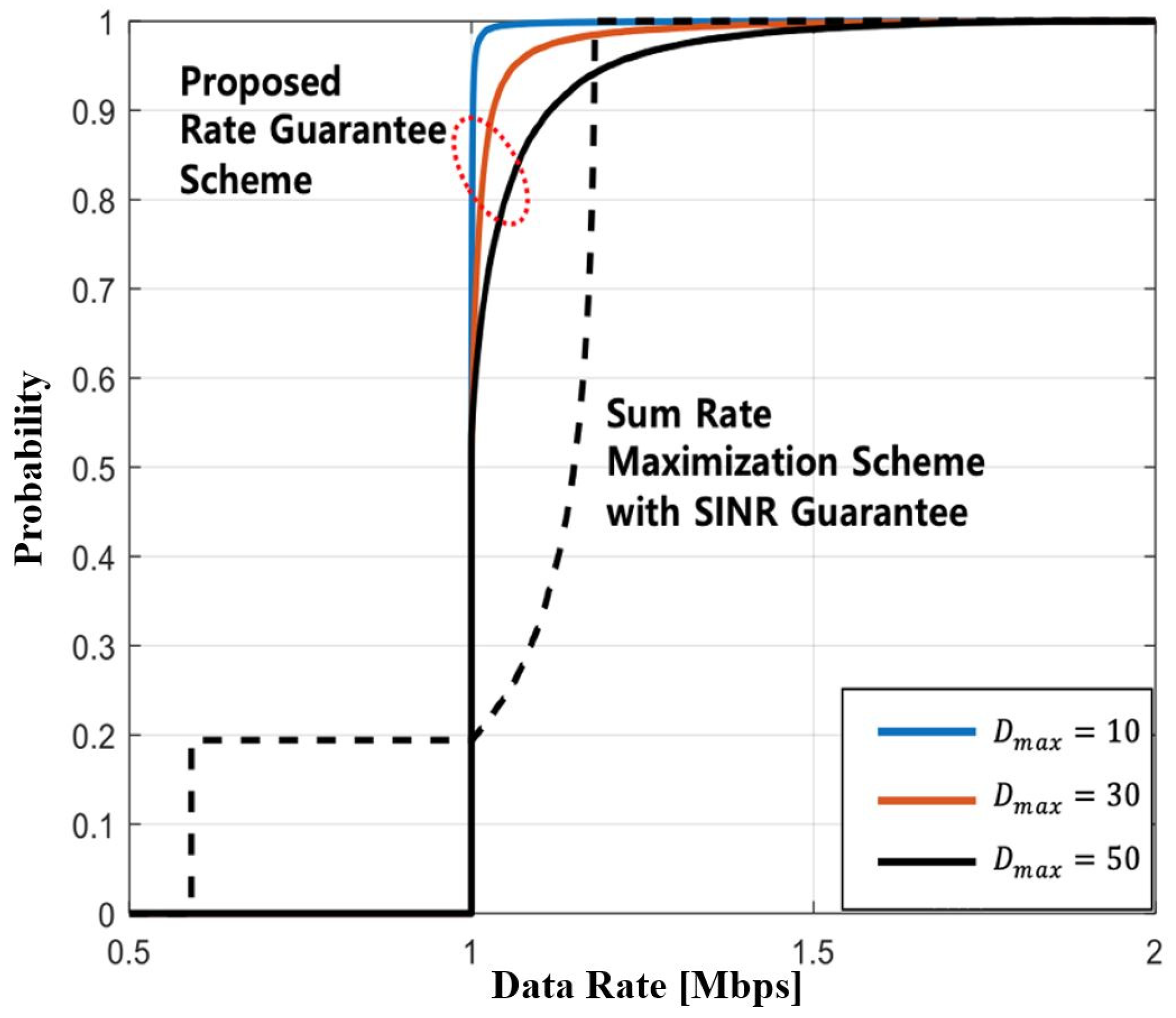1. Introduction
In device-to-device (D2D) communications, devices in the same vicinity can communicate directly with each other without routing the data path through a network infrastructure, e.g., the Uu-interface in the 3rd Generation Partnership Project (3GPP). A device capable of the direct communication is called a DU, and a DU consist of a D2D transmitter (DT) and a D2D receiver (DR). This approach provides a number of advantages. It can reduce the cellular network load because it does not use the cellular network infrastructure. It is possible to spatially reuse uplink frequency resources in the cellular network, thereby increase overall network frequency efficiency. In addition, since it is a short-range communication between devices, the communication delay and the transmission power can be drastically reduced [
1]. In order to take advantage of D2D communication, 3GPP selected D2D technology as a study item in Release 12 in 2011 and conducted a feasibility study in the name of ProSe (Proximity-based Service). In Releases 13 and 14, mission critical enhancement and LTE support for the enhancement of ProSe communication and V2X service were performed. Recently, in Releases 15 and 16, further works have been done to satisfy the high data rate and low latency requirements in 5G systems [
2]. For example, in V2V communications, safety-related data is time-critical and D2D can be a perfect solution [
3]. Energy-efficient D2D based communication has been studied for the smart grid and Internet of Things (IoT), and to meet the transmission delay requirements needed for real-time information collection [
4,
5]. In addition, the problem of reliability during constant bit rate streaming in a real-time streaming network has also been studied [
6].
In D2D-enabled communications, a channel can be matched to a CU-DU pair. Depending on the sharing mode, two separate resources can be allocated to a channel using a dedicated mode, or a single resource can be shared in a shared mode. Matching the CU-DU pair and channel is crucial to maximize system performance with the quality of service (QoS) constraints. In Reference [
7], an optimal power control and resource allocation scheme were proposed to maximize the sum rates. An optimal mode selection for DUs was additionally considered in [
8], and energy efficiency was evaluated as a performance measure in [
9]. In these previous works, each CU was pre-assigned a channel with a fixed channel bandwidth. Then, the best DU was matched to each CU and inherently to each channel, to maximize the sum rate.
In a shared mode, interference is induced and as a consequence, the channel capacity varies. Accordingly, the required channel bandwidth needs to be determined, to satisfy the required target rate with the experienced channel capacity. Since the received SINR may vary, a proper modulation and coding scheme (MCS) needs to be informed during a scheduling process for successful reception [
10,
11]. It is also noted that resource information indicating the amount of resource and its location can be informed and therefore, the channel bandwidth can be adaptively adjusted. The transmit power also needs to be controlled adaptively according to channel bandwidth, as well as channel quality.
Guaranteed bit rate (GBR) service is required in many applications, such as real-time gaming and audio/video communications, requiring a minimum data rate and strict latency. In previous works, power control and resource allocation methods were proposed to guarantee QoS requirements, such as SINR or data rate [
12,
13,
14,
15,
16,
17,
18,
19]. However, since most of these works allocate a single channel of a fixed bandwidth to one CU, there is still a problem in that some users have a SINR or a data rate below their QoS requirements. In other words, when the received SINR is too low due to high co-channel interference, the fixed channel bandwidth may not be wide enough to guarantee the target data rate. Therefore, it is optimal to manage the channel bandwidth and channel assignment jointly. However, to the best of our knowledge, there is no previous research on resource allocation for GBR services in D2D-enabled communications which jointly solves the transmit power control, CU-DU-channel matching, sharing mode selection, and channel bandwidth.
In D2D communications, multiple DUs can be allowed to be assigned to one channel [
18,
19,
20]. Conversely, multiple channels were assigned to one DU in [
21]. In this way the data rate of the DU can be satisfied with higher probability, even though the SINR of the DU is very low. However, the increase in throughput was not significant and the complexity rapidly increased with the number of users performing multiple assignments.
In this paper, we do not consider multiple assignments, which makes it rather straightforward to extend the work with additional computational complexity.
The contributions of this paper are as follows.
In our previous study [
22], a CU unconditionally shared the channel resource with a DU in a D2D underlaid cellular network. In contrast, in this paper, we consider a D2D-enabled communication where the channel sharing mode is considered, i.e., two orthogonal resources are allocated for a channel in a dedicated mode, or one single resource is shared in a shared mode.
In this paper, the SNR-based transmit power control is adopted. However, since the channel bandwidth can be adaptively varied to satisfy the required target rate depending on the experienced channel capacity, the transmit power also needs to be adaptively controlled, based on the channel bandwidth, as well as channel quality.
The Lagrangian relaxation is used for constraint relaxation in the 3-D matching problem with a 3-tuple of CU, DU, and channel. And, two 2-D problems are introduced to solve the problem iteratively with a sub-gradient-based bounding procedure. This sub-optimal problem is less computationally complex than the optimal 3-D matching problem, and it has little performance degradation.
When the number of CUs is different from that of DUs, the 3-D matching problem becomes an unbalanced assignment problem, which can be solved by introducing dummy users based on a modified Hungarian method.
2. System Model
Figure 1 shows an example of channel assignments for the CU, DU, and channel, where
N CUs and
M DUs are serviced with
L channels over a cellular uplink in a single cell environment. Different colors imply different channels and hence, different matchings. The solid blue lines indicate the desired signals and the red dashed lines are co-channel interference. A DU is formed between a D2D transmitter (DT) and a D2D receiver (DR). The DR is located uniformly within a circle with a radius of
and its center is at the DT. For each matching of 3-tuple (CU
n, DU
m, channel
l), the SINR of the CU and DU are different, depending on the channel gain in the links as well as the channel sharing mode. On channel
l, the channel gain between CU
n and the BS is denoted as
, and it is
between CU
n and DR
m. Channel gain includes path loss and fading, where fading follows an independent and identically distributed (i.i.d.) Rayleigh distribution. Similarly, the channel gains from DT
m to DR
m and to the BS are denoted as
and
, respectively.
Figure 2a shows a comparison of the channel bandwidth needed to guarantee the target data rate in relation to matching the CU and DU in each channel. The size of the box corresponds to the bandwidth required for the CU-DU matching to guarantee the target data rate. When CU
n and DU
m are matched on channel
l, the required channel bandwidth is determined by whether it is in either a shared mode or a dedicated mode. If there is one box for one matching, the CU and DU share the channel resource in a shared mode, where a single channel bandwidth
is allocated. If there are two boxes, it is in a dedicated mode where the matched CU and DU use orthogonal resources
and
for CU
n and DU
m, respectively and the channel bandwith comes to their sum,
.
Two matching samples Ⓐ and Ⓑ were selected and are described in more detail in
Figure 2b. For sample Ⓐ, channel
1 is matched for CU
N and DU
1. The channel bandwidth for the dedicated mode,
is smaller than the channel bandwidth for the shared mode,
. Accordingly, the dedicated mode was chosen and its channel bandwidth denoted as
. For sample Ⓑ, the shared mode is more beneficial than the dedicated mode in terms of channel bandwith. The channel bandwidth becomes
for a matching of CU
1 and DU
1.
Figure 2c shows a number of matching combinations, together with their total channel bandwidth. The matching combination represents a collection of all the CUs, DUs matchings, and channels without multiple assignments.
In this study, we aim to find a resource allocation method that minimizes the total channel bandwidth while all users have data rates greater than or equal to the target data rate. Accordingly, we should compare the total channel bandwidths of all the matching combinations to find the optimal one with the smallest total bandwidth. This exhaustive search requires a huge computational complexity of
when the numbers of CUs, DUs, and channels are all equal to
N [
23].
3. Resource Allocation for GBR Services
First, the required channel bandwidth for an arbitrary matching (CU n, DU m, channel l) is derived together with the channel sharing mode requiring a smaller channel bandwidth. Then, the remaining 3-D matching problem is to find the optimal matching combination which minimizes the total channel bandwidth while guaranteeing the target data rate of individual users.
3.1. Channel Bandwidth for Arbitrary Matching, and Channel Sharing Mode Selection
When the channel is divided into two orthogonal resources in a dedicated mode:
The channel bandwidth of channel
l,
is divided into
and
exclusively for CU
n and DU
m, respectively. Note that since there is no co-channel interference between CU and DU, SINR can be simply reduced to SNR. The transmit power
of CU
n is controlled to meet the SNR target
at the BS. Since the transmit power is power-limited at its maximum, it is determined as follows:
where
is the channel bandwidth allocated to CU
n on channel
l and
is the noise power density. Generally,
is much shorter than the cell radius. And hence, it is assumed that the transmit power of DT
m,
is not limited by the maximum transmit power and can be expressed as
where
is the channel bandwidth allocated to DU
m on channel
l. For simplicity, the CU and DU are assumed to have the same SNR target for transmit power control.
When the transmit power is enough to compensate for the channel loss (the channel loss is the inverse of the channel gain), the CU can meet the SNR target. However, as the channel loss increases, the received SNR may be less than
because of the maximum power limit. Then, the bandwidth should be increased so that the data rate of CU
n meets
. The bandwidth for CU
n on channel
l to meet the target data rate is expressed as
On the other hand, since the channel loss between DT and DR is assumed to be small enough, the SNR can always be kept at
. So, the bandwidth for DU
m,
can be given by replacing
with
in (3). Now, the channel bandwidth for a dedicated mode,
can be obtained by adding the two bandwidths for CU
n and DU
m;
When the channel is shared in a shared mode:
Only a single channel bandwidth,
is allocated to both CU
n and DU
m on channel
l. Then, the transmit powers in (1) and (2) are determined with
. Since the same channel is shared by both CU and DU, a co-channel interference exists between them. The SINR for CU
n matched with DU
m on channel
l,
can be expressed as
where
is the power density of CU
n on channel
l and is obtained by dividing the transmit power by the channel bandwidth, i.e.,
. And
is the power density of DU
m, i.e.,
. The SINR,
for DU
m matched with CU
n on channel
l can be derived in a similar way. Then, the channel bandwidth
can be obtained from the above relations while guaranteeing the target rate for both users:
A user requiring a wider channel bandwidth can exactly meet the target rate, while other users may achieve a data rate higher than since the channel bandwidth becomes wider than required.
Channel bandwidth and channel sharing mode selection:
The channel sharing mode requiring a smaller channel bandwidth is selected for channel
l matched to CU
n and DU
m. Then, the channel bandwidth is decided as
3.2. Problem Formulation
We can now see that the channel bandwidth of channel l is different for different matchings of CU n and DU m. And the optimal matching combination can be found by searching for all the possible matching combinations of CUs, DUs, and channels. Therefore, this resource allocation is a joint problem of transmit power control, sharing mode selection, channel bandwidth, and finding the optimal matching combination.
First, we introduce
and
to denote the sets of the transmit power for the CUs and DUs, respectively. Second, we introduce a channel sharing indicator
, which is 1 if the channel
l is in a shared mode for a matching of CU
n and DU
m, and
0 otherwise. We also introduce a matching indicator
, which is 1 if CU
n and DU
m are matched on channel
l, and
0 otherwise. Now the original resource allocation problem can be expressed as
Constraints (8d) and (8e) say that each user is matched to no more than one user, while (8f) says that each channel takes no more than one CU-DU pair. And constraints (8g) and (8h) say that the transmit power of each user can not exceed the maximum. To solve this problem, it is necessary to repeatedly determine the channel bandwidth, transmit power, and channel sharing mode for all the possible matching combinations. This requires very high computational complexity because the number of matching combinations increases exponentially as the number of users increases.
In this paper, once we determine the channel bandwidth of all the possible matchings together with transmit power and channel sharing mode in advance, the remaining problem is reduced to the 3-D matching problem of CU, DU and channel using the calculated channel bandwidths of all possible matchings. The key notations and symbols are listed in
Table A1 in
Appendix A.
3.3. 3-D Assignment of CU, DU, and Channel
Since we calculated the channel bandwidth for arbitrary matching,
in (7), the remaining problem is to find the best matching combination for
N CUs,
M DUs, and
L channels. This 3-D assignment problem can be expressed as
This NP-hard problem is unlikely to be solvable by an algorithm with a time bound that is polynomial in the size of the problem. Meta-heuristic techniques such as Tadu search and Genetic algorithm can be used to solve the NP-hard problem [
24,
25,
26]. These techniques try to find an approximate solution through iterative search based on probability. They have advantage of fast convergence to the vicinity of the optimal solution in a short computation time. However, they cannot guarantee how close the approximate solution can be to the optimal solution. In this paper, we use a sub-optimal algorithm based on the Lagrangian relaxation. In this algorithm, to mitigate the computational complexity, a Lagrangian relaxation for constraint (9e) is used. Multipliers
for
are introduced and then, the following dual function
can be defined as
subject to (9b), (9c), and (9d). Then, it is easy to see that the solution for (10) is a lower bound of the problem in (9a), i.e.,
. From Reference [
27], Equation (10) can be written as:
The optimum solution to (11a),
does not necessarily satisfy (9e), but it does satisfy the remaining constraints. The decomposition of
is used to assign a channel to the matching of CU
n and DU
m. Now, let
, and AP1 in (9a) is equivalent to the following problem:
Constraints (12c) and (12d) can be derived from (9d) and (9e), respectively.
Now, the aim is to find a
that maximizes or nearly maximizes
. A sub-gradient algorithm is used for this purpose. The sub-gradient
can be obtained by differentiating
by
, i.e.,
. The Polyak step size is given as
, where
is not known, so the lower bound is used [
28]. The details of the bounding procedure are summarized in Algorithm 1.
| Algorithm 1 Sub-optimal algorithm based on sub-gradient method |
| 1: Initialize , , |
| 2: while |
| 3: |
| 4: Compute & , i.e., solve RP1 |
|
| 5: Find solution using the solution of RP1 |
|
| 6: If |
| break |
| 7: end if |
| 8: Compute sub-gradient |
| for all |
| 9: If |
| break |
| 10: end if |
| 11: Compute step size |
| 12: Compute new Lagrange multipliers |
| |
| 13: end while |
Since only a single user is assigned to a channel and a channel is allowed to be assigned to a single CU-DU pair, the above matching algorithm works well with a constraint of
N =
M =
L. When the number of CUs is different from that of DUs, a channel is assigned to either a CU or a DU without CU-DU pairing. This is known as an unbalanced assignment problem and can be solved based on the modified Hungarian method [
29]. By introducing dummy users or channels, the constraint of
N =
M =
L can be preserved, i.e., the unbalanced assignment problem can be transformed into a balanced assignment.
4. Numerical Results
We consider a single cell for D2D-enabled cellular communications. Unless otherwise stated, the numbers of CUs, DUs, and channels are set to the same value, i.e.,
N =
M =
L. CUs and DTs are randomly located within a cell. Different path loss formulas are used for device-to-BS and device-to-device based on the 3GPP TR36.814 specification [
30]. The remaining parameters are summarized in
Table 1.
To better understand the operation of the proposed rate-guarantee scheme, snapshots of channel bandwidths and data rates are shown in
Figure 3. For comparison, the sum rate-maximization scheme with a constraint of SINR 11.3 dB is also investigated, where the channel bandwidth is fixed. The proposed scheme changes the channel bandwidth according to the varying channel capacity to guarantee the target data rate.
For a fair comparison, the average channel bandwidth was calculated in the proposed scheme and then the same amount of channel bandwidth was allocated for the sum-rate maximization scheme. As expected, the data rate in the sum rate-maximization scheme varied while it was always higher than or equal to the target data rate in the proposed rate-guarantee scheme. On the other hand, in
Figure 3a the channel bandwidth is fixed, but it must be varied to guarantee the target rate in
Figure 3b. When the channel bandwidth is drawn with two colors, the channel is operated in a dedicated mode due to severe co-channel interference, e.g., see samples 2 and 5 in
Figure 3a and sample 6 in
Figure 3b. In this case, the proposed rate-guarantee scheme allocates a wider channel bandwidth to meet the target rate, while the sum rate maximization scheme halves the channel bandwidth for CU and DU. Then, the SINR is guaranteed but the data rate becomes lower than the target data rate.
Figure 4 investigates the average channel bandwidth by varying the number of CUs for
= 10 m and 50 m. As the number of CUs,
N, increases, a better match for CU-DU-channel can be found with a higher probability, and then the required channel bandwidth can be reduced.
If the distance between devices is short, e.g., 10 m, there is a very high possibility of a Line of Sight (LoS) path. Then, the fading should follow the Rician distribution. We also simulated the proposed scheme under Rician fading for . We assume K factor is 7 dB. Owing to the LoS path component, DUs experience comparatively better channel quality. Then, DTs tend to transmit with a lower power, which results in reduced interference. The average channel bandwidth decreases compared with the Rayleigh fading case but the impact is marginal.
The proposed sub-optimal algorithm based on a Lagrangian relaxed algorithm can achieve almost the same performance as that of the optimal algorithm. The optimal 3-D matching problem can be solved by an exhaustive search with huge computational complexity. On the other hand, in the proposed sub-optimal algorithm, the 3-D matching problem is converted into two 2-D matching problems to obtain an approximate solution based on the Hungarian method. With a computational complexity of for each iteration, this computational complexity is much lower than that of the optimal algorithm.
We also investigated the case, denoted Pre-assigned, where each CU was pre-assigned a channel. The remaining channel assignment problem was to find the best matches between CU and DU, which is simply a 2-D channel assignment problem. The proposed 3-D assignment algorithm outperformed the pre-assigned case, and the performance gain was higher with a larger and more CUs. For example, with = 50 m and 32 CUs, a 33% wider channel bandwidth was required for the pre-assigned case than the optimal one. As the cell radius increases, the interference between the matched CU-DU pair tend to decrease and the effectiveness of the resource allocation may diminish. We additionally simulated the proposed scheme for R = 200 m. Unlike the case with R = 100 m, the proposed scheme reduces the average channel bandwidth only by 4% with R = 200 m. We can say that the proposed resource allocation scheme is more effective for a dense small cell deployment of 5G networks.
Figure 5 compares the cumulative distribution function (CDF) of the data rate when
N = 32 by varying
. As expected, the proposed resource allocation scheme guarantees the target data rate. As
increases, the DTs tend to transmit with a higher power, which results in higher interfernce in a shared mode. Then, the required channel bandwidth is increased, and higher data rates than
are observed with a higher probability as
increases. When
= 50 m in the sum rate-maximization scheme with SINR guarantee, approximately 20% of users could not meet the target rate. These users suffered from severe co-channel interference in a shared mode. Consequently, they were forced to be in a dedicated mode to guarantee the target SINR but the target data rate is not guaranteed with a fixed channel bandwidth, as seen in
Figure 3. It is interesting to note that only 7% of the channels are in a dedicated mode in the proposed scheme, since the channel bandwidth is adaptively adjusted according to the SINR.
Table 2 shows the average bandwidth per user when the number of CUs
N is 16 with varying numbers of DUs
M, from 0 to 16. The average bandwidth per user is calculated by dividing the total bandwidth by the total number of users, i.e.,
N +
M. This is a measure of how many users can be serviced with a given bandwidth. When there are only 16 CUs, i.e.,
M = 0, there is no co-channel interference. Since SNR based power control is applied, the received SINR always meets the target SNR of 15 dB and the channel bandwidth of 0.2 MHz suffices for the target data rate. When DUs emerges, the DUs tries to find a best match with a CU. As a special case of
M = 1, if a DU is too close to the BS, severe interference is induced in the BS. Then, this DU is forced to operate in a dedicated mode. Assuming a uniform distribution, a user falls into this situation with a probabiity of 12%, which corresponds to a sharing rate of 0.88. Note that since fading varies over channels, this best match may differ for different channels. So the resource allocation becomes a 3-D matching problem of CU, DU, and channels. When a channel is in a dedicated mode, the channel bandwidth becomes 0.4 MHz, where each user (CU or DU) is allocated half of the bandwidth. When a channel is in a shared mode, this implies that the required channel bandwidth is smaller than 0.4 MHz. So, as more channels are operated in a shared mode, the average bandwidth per user can be decreased.
5. Conclusions
We proposed an efficient resource allocation scheme for GBR services in D2D-enabled communications, with the aim of minimizing the total channel bandwidth while guaranteeing the target data rate. This is a joint optimization problem of transmit power, channel sharing, channel bandwidth, and 3-D matching of the CU-DU-channel. To mitigate the computational complexity of the 3-D matching problem, Lagrangian relaxation was used, and two 2-D problems were solved iteratively with a sub-gradient-based bounding procedure.
Through intensive simulations, the proposed scheme was found to guarantee the target rate with the minimum channel bandwidth, unlike the sum rate-maximization scheme. When each channel is pre-assigned to a CU, the matching problem is simply 2-D matching of the CU-DU excluding channel, but it requires about a 33% wider average channel bandwidth than the proposed scheme with = 50 m and 30 CUs. The impacts of the maximum D2D distance, the number of CUs, and the number of DUs were also investigated.
Since the importance of real-time traffic such as GBR services is expected to grow, a resource allocation scheme with a rate-guarantee constraint is inevitablely required for future cellular communications. This work can be extended to a mixture of traffics with different QoS requirements and to V2X environments.
